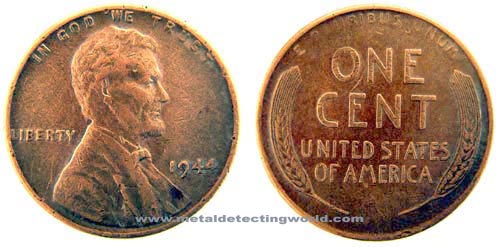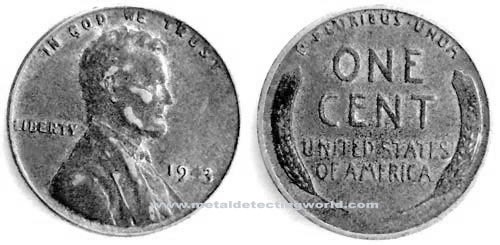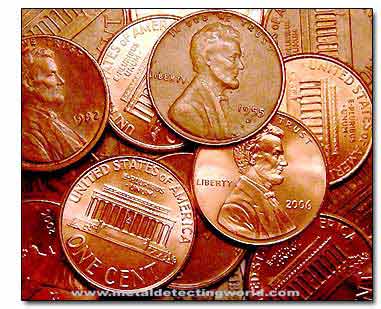US Small Cents 1909 To Date
(continued from Page 1)
LINCOLN TYPE, Wheat Ears Reverse - "Wheat Penny" 1909 - 1958
VARIETY 1 - Bronze, 1909 - 1942, 1944 - 1958

Specifications:
Diameter: 19 mm
Weight: 3.11 grams or 48 grains
Edge: Plain
Composition: 95% copper, 5% tin/zink
Quantity minted: 21,063,560,620
Proofs minted: 3,851,763
Mint marks: D and S
Designers: Victor D. Brenner
REVERSE: The designer's initials VDB appear on the reverse of a limited quantity of cents of 1909
Key Dates and Coin Values:
• 1909S V.D.B.; G-4: $370.00, EF-40: $580.00
• 1909S V.D.B. Matte Proof; MS-63: $1,550
• 1909 Matte Proof; MS-63: $325.00
• 1909S; G-4: $38.00, EF-40: $110.00
• 1909S S over horizontal S; G-4: $38.00, EF-40: $115.00
• 1914D (Beware of altered date or mint mark; no V.D.B. on shoulder of genuine 1914D cent); G-4: $85.00, EF-40: $455.00
• 1917 Doubled die obverse; G-4: $80.00, EF-40: $380.00
• 1917 Matte proof; n/a
• 1921S; G-4: $0.95, EF-40: $15.00
• 1922D; G-4: $8.00, EF-40: $25.00
• 1922 no D; G-4: $225.00, EF-40: $1,450
• 1922 Weak D (beware of removed mint mark); G-4: $28.00, EF-40: $125.00
• 1923S; G-4: $1.75, EF-40: $19.00
• 1924D; G-4: $9.00, EF-40: $65.00
• 1924S; G-4: $0.95, EF-40: $12.00
• 1926S; G-4: $2.50, EF-40: $13.00
• 1931S; G-4: $36.00, EF-40: $65.00
• 1936 Doubled die obverse; VF-20: $50.00, EF-40: $80.00
• 1944D D over S; G-4: $130.00, EF-40: $180.00
• 1946S S over D; G-4: $25.00, EF-40: $75.00
• 1955 Doubled die obverse; G-4: $550.00, EF-40: $650.00
• 1956D Traces of second mint mark below D; G-4: $12.00, EF-40: $30.00
Average coin values of other dates: G-4 - $0.15, EF-40 - $0.25
VARIETY 2 - Zink-Coated Steel, 1943 only
World War II Steel 1943 Penny

Specifications:
Diameter: 19 mm
Weight: 2.70 grams or 42.5 grains
Edge: Plain
Composition: Zink-coated Steel
Quantity minted: 1,093,838,670
Proofs minted: None
Mint marks: D and S
Designers: Victor D. Brenner
Key Dates and Coin Values:
• 1943 Boldly doubled; G-4: $6.0, EF-40: $18.00
Average coin values of other dates: G-4 - $0.25, EF-40 - $1.75
Owing to a shortage of copper during the critical war year 1943, the Treasury Department resorted to the use of zink-coated steel for small cents. No bronze cents were officially issued in 1943. A few specimens struck on bronze planchets by error are known to exist.
LINCOLN TYPE, Memorial Reverse 1959 To Date

The Lincoln Memorial reverse was introduced in 1959 on the 150th anniversary of Lincoln's birth.
Specifications:
Diameter: 19 mm
Weight: 3.11 grams or 48 grains
Edge: Plain
Composition: 95% copper, 5% tin and zinc. 1962-1982 - composition changed to 95% copper, 5% zinc
Quantity minted: 21,063,560,620+
Proofs minted: 3,851,763
Mint marks: D and S
Designers: Obverse Victor D. Brenner, Reverse Frank Gasparro 1959-1962
Key Dates and Coin Values:
• 1960 Small date; MS-65: $3.00
• 1970S Small date (high 7); MS-65: $35.00
• 1971S Double die obverse; Proof-65: $655.00
• 1972 Double die obverse; MS-65: $455.00
Average coin values of other dates: MS-65 - $0.15
COPPER PLATED ZINC CENTS, 1982 to Date
In 1982 the composition of Lincoln Memorial cent was changed to copper plated zinc, thus making the coin 20% lighter than the copper cents
Specifications:
Diameter: 19 mm
Weight: 2.5 grams
Edge: Plain
Composition: Core is 99.2% zinc, 0.8% copper, with a plating of pure copper; Total content is 97.5% zinc, 2.5% copper.
Mints: Philadelphia, Denver (mint mark D) and San Francisco (mint mark S)
Key Dates and Coin Values:
• 1983 Double die reverse; MS-65: $225.00
• 1984 Doubled ear; MS-65: $155.00
• 1995 Double die obverse; MS-65: $38.00
Average coin values of other dates: MS-65 - $0.12
1,579,324 cents dated 1974 were struck in aluminum as experimental pieces. None was placed in circulation and most were later destroyed. One was preserved for the National Collection in the Smithsonian Institution.
Some of the cents minted since 1994 show the faint trace of a mint mark and are believed to be the result of the letter having been removed from the master die during production of working dies for coinage.
The "phantom" mint mark pieces were produced in Philadelphia but show traces of either a D or S. Values for such pieces are not significantly higher than for normal pieces.